

Radiation Protection. Health effects are the central focus of EPA's Radiation Protection Programs.
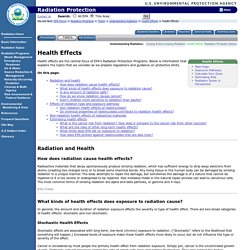
Below is information that explains the topics that we consider as we prepare regulations and guidance on protective limits. On this page: Medical Uses of Nuclear Materials. On this page: Role of NRC and Other Agencies in Regulating the Medical Use of Nuclear Materials Regulatory authority over the medical use of ionizing radiation is shared among several Federal, state, and local government agencies.
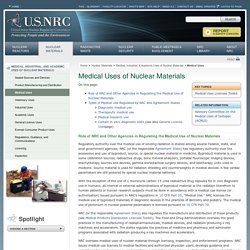
NRC (or the responsible Agreement State) has regulatory authority over the possession and use of byproduct, source, or special nuclear material in medicine. Byproduct material is used in some calibration sources, radioactive drugs, bone mineral analyzers, portable fluoroscopic imaging devices, brachytherapy sources and devices, gamma stereotactical surgery devices, and teletherapy units used in medicine. Radiation and Life. There would be no life on Earth without lots of sunlight, but we have increasingly recognised that too much of it on our persons is not a good thing.
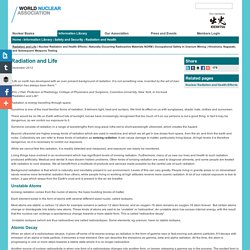
In fact it may be dangerous, so we control our exposure to it. Sunshine consists of radiation in a range of wavelengths from long-wave infra-red to short-wavelength ultraviolet, which creates the hazard. Beyond ultraviolet are higher energy kinds of radiation which are used in medicine and which we all get in low doses from space, from the air, and from the earth and rocks. Collectively we can refer to these kinds of radiation as ionising radiation. It can cause damage to matter, particularly living tissue.
Investigating the impact of radiation and radioactive contamination on forensic trace evidence - ANSTO. The collection, handling and analysis of forensic evidence from a radiological crime scene presents significant challenges.

The potential for the use of radioactive materials in a malevolent act has been heightened in recent years, and it is highly likely that some or all of the physical evidence recovered after such an event may have been exposed to ionising radiation or contaminated with radioactive material. Authorities need a way to safely collect, handle and examine potential evidence contaminated with radioactive material. This research explores the impact that high-energy alpha particles have on traditional evidence types including fingermarks, DNA, hairs and fibres. The study also assesses existing methods and develops new forensic procedures for handling and processing traditional evidence contaminated with alpha emitting radioactive material. Advantages and Disadvantages of Radioactivity. If radiation collides with molecules in the air or in your body, it throws out of them electrons.

By throwing out electrons you produce charged particles called ions. This means it is the radiation responsible for ionising molecules. If this happens in our body, the cells may die or they may undergo a change called a mutation. The result is called radiation sickness. Radioactive substances and their impact on health. Health Effects of Ionising Radiation.
Ionizing Radiation. (Updated 22 May 2015) Natural sources account for most of the radiation we all receive each year.The nuclear fuel cycle does not give rise to significant radiation exposure for members of the public, and even in two major nuclear accidents – Three Mile Island and Fukushima – exposure to radiation has caused no harm to the public.Radiation protection standards assume that any dose of radiation, no matter how small, involves a possible risk to human health.

This deliberately conservative assumption is increasingly being questioned. Fear of radiation causes much harm. Expressed particularly in government edicts following the Fukushima accident (and also Chernobyl), it has caused much suffering and many deaths. Q&A: Health effects of radiation exposure. Concern remains over the potential effect on human health from radiation leaks at the stricken Fukushima Daiichi nuclear plant.
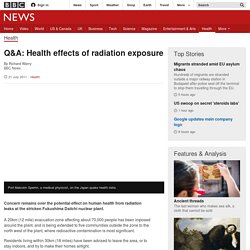
A 20km (12 mile) evacuation zone affecting about 70,000 people has been imposed around the plant, and is being extended to five communities outside the zone to the north west of the plant, where radioactive contamination is most significant. Residents living within 30km (18 miles) have been advised to leave the area, or to stay indoors, and try to make their homes airtight. Experts believe that swift action of this sort should have minimised the risk to human health, but there are worries about the level of radiation to which emergency workers have been exposed, and about possible contamination of food and water supplies. Fukushima disaster: Radiation levels posing cancer risks on fourth anniversary of earthquake.
By North Asia correspondent Matthew Carney Updated Four years ago today Japan was hit with a magnitude 9.0 earthquake and massive tsunami that caused widespread destruction, leaving almost 22,000 people dead or missing and triggering a crisis at the Fukushima Daiichi nuclear plant.
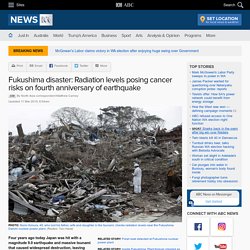
The triple nuclear meltdown was the world's worst nuclear disaster since Chernobyl. About 120,000 people still cannot return their homes because of high radiation levels, but the issue of long-term health implications like cancer are causing the greatest concern and controversy in Japan. Before the disaster, there was just one to two cases of thyroid cancers in a million Japanese children but now Fukushima has more than 100 confirmed or suspected cases, having tested about 300,000 children. Megumi Muto's daughter Nana has undergone scans to determine if the lumps in her thyroid glands have grown. "I feel angry. Engineer says Fukushima cancer spike needs to be investigated "It's more expensive so I'm stuck here.
"